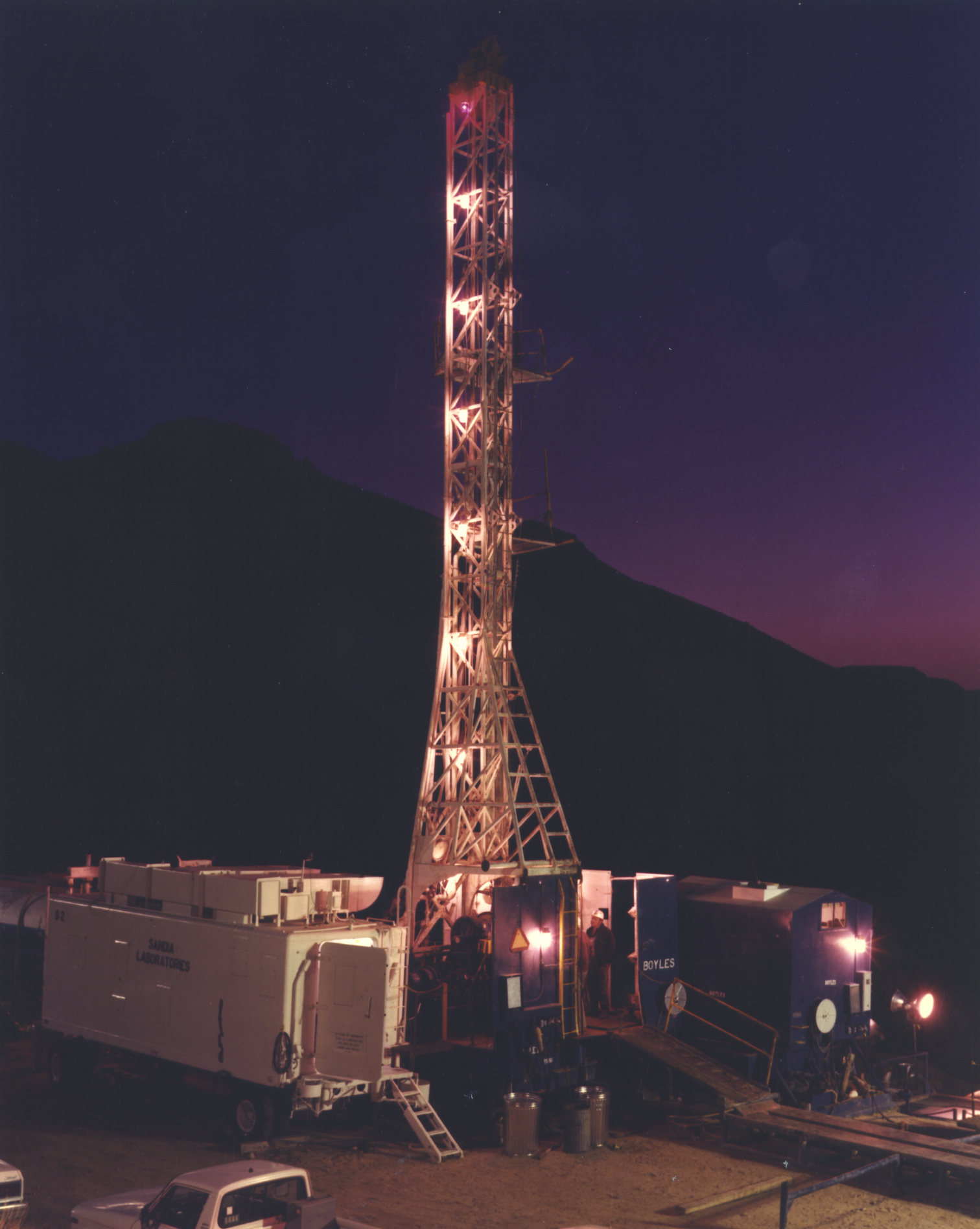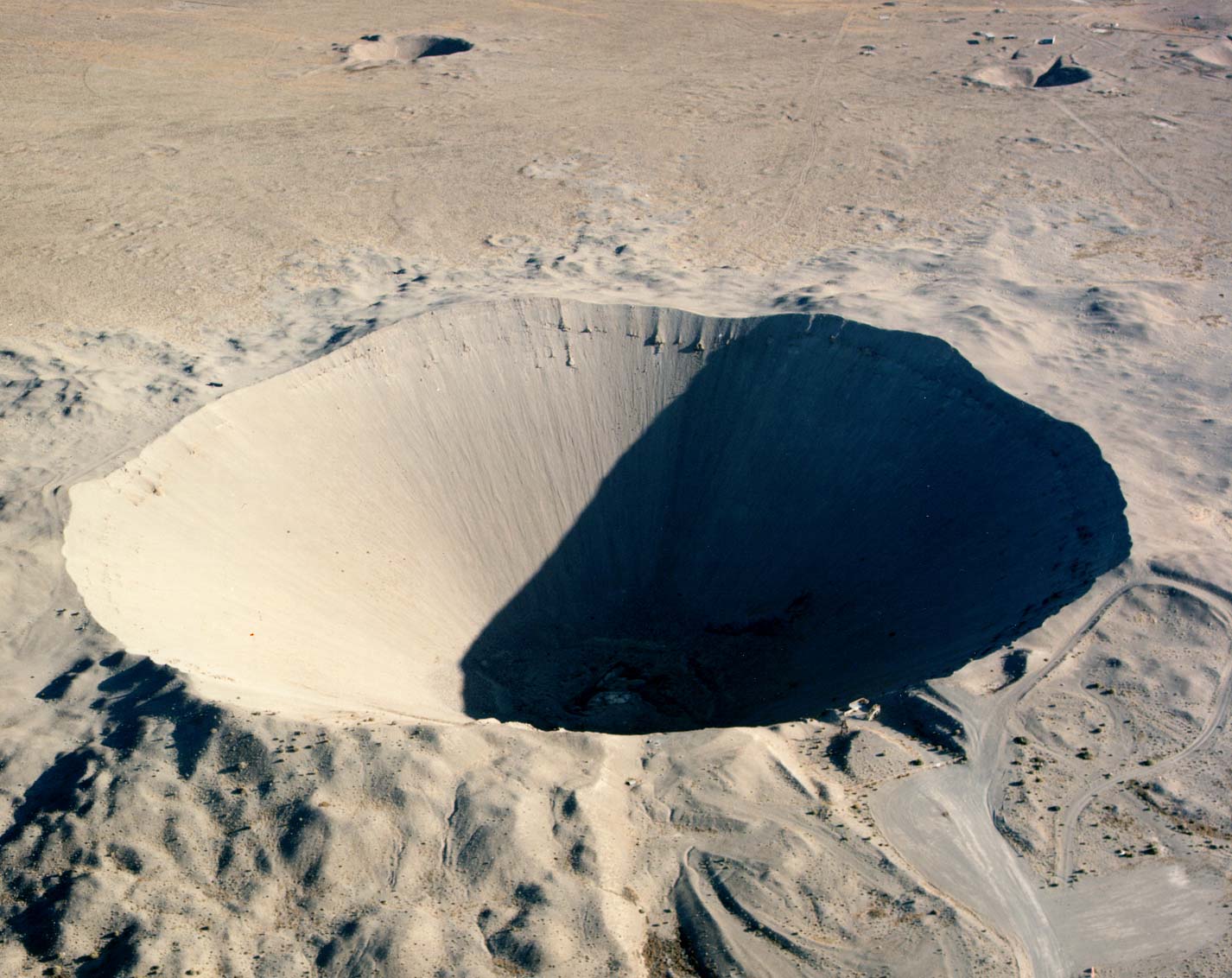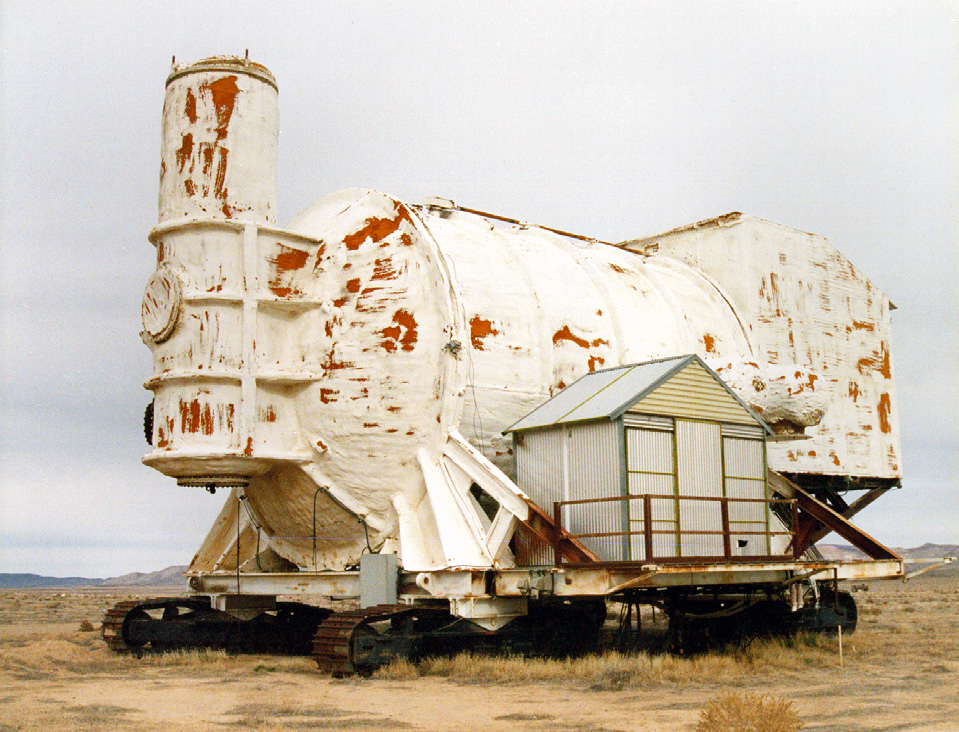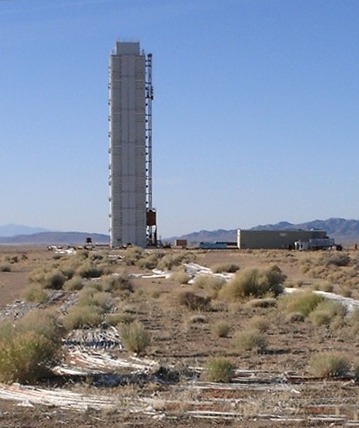Yucca Flat on:
[Wikipedia]
[Google]
[Amazon]
 Yucca Flat is a closed desert drainage basin, one of four major nuclear test regions within the
Yucca Flat is a closed desert drainage basin, one of four major nuclear test regions within the
/ref>
 The open, sandy
The open, sandy
 The first test explosion at Yucca Flat came after five prior atmospheric tests at nearby Area 5 as part of
The first test explosion at Yucca Flat came after five prior atmospheric tests at nearby Area 5 as part of
 A dramatically different test shot was the "Sedan" test of
A dramatically different test shot was the "Sedan" test of
 Area 8 hosted the "Baneberry" shot of
Area 8 hosted the "Baneberry" shot of
 As part of
As part of
 Three tests planned for 1993 have been abandoned in place, two in Yucca Flat. The
Three tests planned for 1993 have been abandoned in place, two in Yucca Flat. The
 The radioactivity present on the ground in Area 1 provides a radiologically-contaminated environment for the training of
The radioactivity present on the ground in Area 1 provides a radiologically-contaminated environment for the training of
Yucca Flat
at the Online Nevada Encyclopedia. Includes photo gallery. {{Authority control Landforms of Nye County, Nevada Nevada Test Site Basins of Nevada
 Yucca Flat is a closed desert drainage basin, one of four major nuclear test regions within the
Yucca Flat is a closed desert drainage basin, one of four major nuclear test regions within the Nevada Test Site
The Nevada National Security Site (N2S2 or NNSS), known as the Nevada Test Site (NTS) until 2010, is a United States Department of Energy (DOE) reservation located in southeastern Nye County, Nevada, about 65 miles (105 km) northwest of the ...
(NTS), and is divided into nine test sections: Areas 1 through 4 and 6 through 10. Yucca Flat is located at the eastern edge of NTS, about north of Frenchman Flat
Frenchman Flat is a hydrographic basin in the Nevada National Security Site south of Yucca Flat and north of Mercury, Nevada. The flat was used as an American nuclear test site and has a dry lake bed (Frenchman Lake) that was used as a 1950s ...
, and from Las Vegas, Nevada
Las Vegas (; Spanish for "The Meadows"), often known simply as Vegas, is the 25th-most populous city in the United States, the most populous city in the state of Nevada, and the county seat of Clark County. The city anchors the Las Vegas ...
. Yucca Flat was the site for 739 nuclear test
Nuclear weapons tests are experiments carried out to determine nuclear weapons' effectiveness, Nuclear weapon yield, yield, and explosive capability. Testing nuclear weapons offers practical information about how the weapons function, how detona ...
s – nearly four of every five tests carried out at the NTS.
Yucca Flat has been called "the most irradiated, nuclear-blasted spot on the face of the earth".Gerald H. Clarfield and William M. Wiecek (1984). ''Nuclear America: Military and Civilian Nuclear Power in the United States 1940–1980'', Harper & Row, New York, p. 202. In March 2009, ''TIME
Time is the continued sequence of existence and events that occurs in an apparently irreversible succession from the past, through the present, into the future. It is a component quantity of various measurements used to sequence events, to ...
'' identified the 1970 Yucca Flat Baneberry Test, where 86 workers were exposed to radiation, as one of the world's worst nuclear disasters.The Worst Nuclear Disasters/ref>
Geology
 The open, sandy
The open, sandy geology
Geology () is a branch of natural science concerned with Earth and other astronomical objects, the features or rocks of which it is composed, and the processes by which they change over time. Modern geology significantly overlaps all other Ear ...
of Yucca Flat in the Tonopah Basin
The Great Basin Desert is part of the Great Basin between the Sierra Nevada and the Wasatch Range. The desert is a geographical region that largely overlaps the Great Basin shrub steppe defined by the World Wildlife Fund, and the Central Basin ...
made for straightforward visual documentation of atmospheric nuclear tests. When testing went underground, deep layers of sedimentary soil from the erosion of the surrounding mountains allowed for relatively easy drilling of test holes.
Hundreds of subsidence crater
__NOTOC__
A subsidence crater is a hole or depression left on the surface of an area which has had an underground (usually nuclear) explosion. Many such craters are commonly present at bomb testing areas; one notable example is the Nevada Test S ...
s dot the desert floor. A crater could develop when an underground nuclear explosion vaporized surrounding bedrock and sediment. The vapor cooled to liquid lava and pooled at the bottom of the cavity created by the explosion. Cracked rock and sediment layers above the explosion often settled into the cavity to form a crater.
At the south end of Yucca Flat is Yucca Lake, also called Yucca Dry Lake. The dry, alkaline lake bed holds a restricted runway ( Yucca Airstrip) which was built by the Army Corps of Engineers before nuclear testing began in the area. To the west of the dry lake bed is News Nob, a rocky outcropping from which journalists and VIPs were able to watch atmospheric nuclear tests at Yucca Flat.
Nearby
West of the dry lake bed, cresting the top of Yucca Pass, is Control Point, or CP-1, the complex of buildings which contains testing and monitoring equipment for nuclear tests, and a cafeteria that seats 32. CP-1 overlooks both Yucca and Frenchman Flats. Today, Control Point is the center for support of all activity at the NTS. A subsidence crater in nearby Area 5 is home to a number of storage containers holding contaminated scrap metal and debris, and is subject to periodic monitoring of radioactivity levels.Nuclear testing
Yucca Flat saw 739 nuclear tests, including 827 separate detonations. The higher number of detonations is from single tests that included multiple nuclear explosions occurring within a 0.1 second time window and inside a diameter circle. Sixty-two such tests took place at NTS. No test at Yucca Flat ever exceeded 500 kilotons of expected yield. Tests of larger explosions were carried out at Rainier Mesa andPahute Mesa
Pahute Mesa or Paiute Mesa is one of four major nuclear test regions within the Nevada National Security Site (NNSS). It occupies in the northwest corner of the NNSS in Nevada. The eastern section is known as Area 19 and the western section as ...
, as their geology allowed deeper test shafts.
First tests
 The first test explosion at Yucca Flat came after five prior atmospheric tests at nearby Area 5 as part of
The first test explosion at Yucca Flat came after five prior atmospheric tests at nearby Area 5 as part of Operation Ranger
Operation Ranger was the fourth American nuclear test series. It was conducted in 1951 and was the first series to be carried out at the Nevada Test Site.
All the bombs were dropped by B-50D bombers and exploded in the open air over Frenchma ...
. On October 22, 1951, the "Able" test of Operation Buster was detonated at the top of a tower in Area 7, resulting in a nuclear yield less than an equivalent kilogram of TNT; the shot was a fizzle. It was the world's first failure of a nuclear device. Over the next two weeks, four successful tests were conducted via airdrop, with bomber aircraft releasing nuclear weapons over Area 7.
The first underground test at NTS was the "Uncle" shot of Operation Jangle
Operation or Operations may refer to:
Arts, entertainment and media
* Operation (game), ''Operation'' (game), a battery-operated board game that challenges dexterity
* Operation (music), a term used in musical set theory
* Operations (magazine ...
. Uncle detonated on November 29, 1951 within a shaft sunk into Area 10.
Operation Plumbbob
In Area 9, the 74-kiloton "Hood" test on July 5, 1957, part ofOperation Plumbbob
Operation Plumbbob was a series of nuclear tests that were conducted between May 28 and October 7, 1957, at the Nevada Test Site, following '' Project 57'', and preceding '' Project 58/58A''.
Background
The operation consisted of 29 explosion ...
, was the largest atmospheric test ever conducted within the continental United States; nearly five times larger in yield than the bomb dropped on Hiroshima. A balloon carried Hood up to above the ground where it was detonated. Over 2,000 troops took part in the test in order to train them in conducting operations on the nuclear battlefield. of iodine-131
Iodine-131 (131I, I-131) is an important radioisotope of iodine discovered by Glenn Seaborg and John Livingood in 1938 at the University of California, Berkeley. It has a radioactive decay half-life of about eight days. It is associated with nu ...
(131I) were released into the air. With a relatively brief half-life of eight days, 131I is useful as a determinant in tracking specific nuclear contamination events. Iodine-131 comprises about 2% of radioactive materials in a cloud of dust stemming from a nuclear test, and causes thyroid problems if ingested.
The "John" shot of Plumbbob, on July 19, 1957, was the first test firing of the nuclear-tipped AIR-2 Genie
The Douglas AIR-2 Genie (previous designation MB-1) was an unguided air-to-air rocket with a 1.5 kt W25 nuclear warhead. It was deployed by the United States Air Force (USAF 1957–1985) and Canada (Royal Canadian Air Force 1965–68, Air Co ...
air-to-air rocket designed to destroy incoming enemy bombers with a nuclear explosion. The two-kiloton warhead exploded approximately above five volunteers and a photographer who stood unprotected at "ground zero" in Area 10 to demonstrate the purported safety of battlefield nuclear weapons to personnel on the ground. The test also demonstrated the ability of a fighter aircraft to deliver a nuclear-tipped rocket and avoid being destroyed in the process. A Northrop F-89J
The Northrop F-89 Scorpion was an American all-weather, twin-engined interceptor aircraft built during the 1950s, the first jet-powered aircraft designed for that role from the outset to enter service. Though its straight wings limited its per ...
fired the rocket.
Project Plowshare
 A dramatically different test shot was the "Sedan" test of
A dramatically different test shot was the "Sedan" test of Operation Storax
Operation Storax was a series of 47 nuclear tests conducted by the United States in 1962–1963 at the Nevada Test Site. These tests followed the ''Operation Fishbowl'' series and preceded the ''Operation Roller Coaster'' series.
British test ...
on July 6, 1962, a 104 kiloton shot for Project Plowshare
Project Plowshare was the overall United States program for the development of techniques to use nuclear explosives for peaceful construction purposes. The program was organized in June 1957 as part of the worldwide Atoms for Peace efforts. As ...
which sought to discover whether nuclear weapons could be used for peaceful means in creating lakes, bays or canals. The explosion displaced twelve million tons of earth, creating a crater wide and deep in Area 10. For an underground shot, a relatively large amount of energy was vented to the atmosphere, estimated to be 2.5 kilotons (7.4 bars of pressure). Two radioactive dust clouds rose up from the explosion and traveled across the United States, one at and the other at . Both dropped radioactive particles across the USA before crossing into the sky above the Atlantic Ocean. Among many other radioisotopes, the clouds carried of 131I.
Sedan Crater was added to the National Register of Historic Places
The National Register of Historic Places (NRHP) is the United States federal government's official list of districts, sites, buildings, structures and objects deemed worthy of preservation for their historical significance or "great artistic v ...
in 1994.
Baneberry
 Area 8 hosted the "Baneberry" shot of
Area 8 hosted the "Baneberry" shot of Operation Emery
The United States's Emery nuclear test series was a group of 16 nuclear weapons test
Nuclear weapons tests are experiments carried out to determine nuclear weapons' effectiveness, yield, and explosive capability. Testing nuclear weapons o ...
on December 18, 1970. The Baneberry 10 kiloton test detonated below the surface but its energy cracked the soil in unexpected ways, causing a fissure near ground zero and the failure of the shaft and cap. A plume of fire and dust was released three and a half minutes after initiation, raining fallout on workers in different locations within NTS. The radioactive plume released of radioactive material, including of iodine-131
Iodine-131 (131I, I-131) is an important radioisotope of iodine discovered by Glenn Seaborg and John Livingood in 1938 at the University of California, Berkeley. It has a radioactive decay half-life of about eight days. It is associated with nu ...
. After dropping a portion of its material locally, the plume's lighter particles were carried to three altitudes and conveyed by winter storms and the jet stream to be deposited heavily as radionuclide-laden snow in Lassen and Sierra counties in northeast California, and to lesser degrees in southern Idaho, northern Nevada and some eastern sections of Oregon and Washington states. The three diverging jet stream layers conducted radionuclides across the US to Canada, the Gulf of Mexico and the Atlantic Ocean.
Some 86 workers at the site were exposed to radioactivity, but according to the Department of Energy none received a dose exceeding site guidelines and, similarly, radiation drifting offsite was not considered to pose a hazard by the DOE. In March 2009, TIME magazine
''Time'' (stylized in all caps) is an American news magazine based in New York City. For nearly a century, it was published weekly, but starting in March 2020 it transitioned to every other week. It was first published in New York City on Ma ...
identified the Baneberry Test as one of the world's worst nuclear disasters.
Two US Federal court cases resulted from the Baneberry event. Two NTS workers who were exposed to high levels of radiation from Baneberry died in 1974, both from acute myeloid leukemia. The district court found that although the Government had acted negligently, the radiation from the Baneberry test did not cause the leukemia cases. The district decision was upheld on appeal in 1996.
Huron King
 As part of
As part of Operation Tinderbox
Operation Tinderbox was a series of 14 nuclear tests conducted by the United States in 1979–1980 at the Nevada Test Site. These tests followed the ''Operation Quicksilver (1978), Operation Quicksilver'' series and preceded the ''Operation Gua ...
, on June 24, 1980, a small satellite prototype (DSCS III
The Defense Satellite Communications System (DSCS) is a United States Space Force satellite constellation that provides the United States with military communications to support globally distributed military users. Beginning in 2007, DSCS is be ...
) was subjected to radioactivity from the "Huron King" shot in a vertical line-of-sight (VLOS) test undertaken in Area 3. This was a program to improve the database on nuclear hardening design techniques for defense satellites. The VLOS test configuration involved placing a nuclear device (less than 20 kilotons) at the bottom of a shaft. A communications satellite or other experiment was placed in a partially evacuated test chamber simulating a space environment. The test chamber was parked at ground level at the top of the shaft. At zero time, the radiation from the device shot up the vertical pipe to the surface test chamber. Mechanical closures then intercepted and sealed the pipe, preventing the explosive shock wave from damaging the targets. The test chamber was immediately disconnected by remote control from the pipe and quickly winched to safety before the ground could subside to form a crater. The Huron King test cost US$10.3 million in 1980 (equivalent to $ million today).
Last test
The final test at Yucca Flat (also the last test at the entire Nevada Test Site) was Operation Julin's "Divider" on September 23, 1992, just prior to the moratorium temporarily ending all nuclear testing. Divider was a safety experiment test shot that was detonated at the bottom of a shaft sunk into Area 3.Abandoned tests
Comprehensive Nuclear-Test-Ban Treaty
The Comprehensive Nuclear-Test-Ban Treaty (CTBT) is a multilateral treaty to ban nuclear weapons test explosions and any other nuclear explosions, for both civilian and military purposes, in all environments. It was adopted by the United Nati ...
had been strongly supported by the UN General Assembly in 1991, and negotiations began in earnest in 1993. The United States, on October 3, 1992, suspended all nuclear weapons testing programs in anticipation of eventual ratification of the treaty. The partially assembled cabling, towers and equipment for shot "Icecap" in Area 1 and shot "Gabbs" in Area 2 lie amid weeds and blowing dust, waiting for a possible resumption of nuclear testing. Shot "Greenwater" awaits its fate in Area 19 at Pahute Mesa
Pahute Mesa or Paiute Mesa is one of four major nuclear test regions within the Nevada National Security Site (NNSS). It occupies in the northwest corner of the NNSS in Nevada. The eastern section is known as Area 19 and the western section as ...
. "Icecap" was to be a joint US-UK test event.
Radioactivity
UGTA
The United States Department of Energy produced a report in April, 1997, on a subproject of the Nevada Environmental Restoration Project. The larger project involves environmental restoration and mitigation activities in the NTS,Tonopah Test Range
The Tonopah Test Range (TTR, also designated as Area 52) is a highly classified, restricted military installation of the United States Department of Defense, and United States Department of Energy ( nuclear stockpile stewardship) located about ...
, Nellis Air Force Range
The Nevada Test and Training Range (NTTR) is one of two military training areas at the Nellis Air Force Base Complex in Nevada and used by the United States Air Force Warfare Center at Nellis Air Force Base. The NTTR land area includes a "sim ...
, and eight further sites in five other states. The Underground Test Area (UGTA) subproject focuses on defining the boundaries of areas containing unsafe water contaminated with radionuclides from underground nuclear tests. The ongoing subproject is tasked with predicting the future extent of contaminated water due to natural flow and it is expected to quantify safe limits for human health. Yucca Flat was identified as a Corrective Action Unit (CAU). Because of the great expense and virtual impossibility of cleaning up the Nevada Test Site, it has been characterized as a "national sacrifice zone A sacrifice zone or sacrifice area (often termed a national sacrifice zone or national sacrifice area) is a geographic area that has been permanently impaired by heavy environmental alterations or economic disinvestment, often through locally unwan ...
."
USGS
In 2003, theUnited States Geological Survey
The United States Geological Survey (USGS), formerly simply known as the Geological Survey, is a scientific agency of the United States government. The scientists of the USGS study the landscape of the United States, its natural resources, ...
(USGS) collected and processed magnetotellurics
Magnetotellurics (MT) is an electromagnetic geophysical method for inferring the earth's subsurface electrical conductivity from measurements of natural geomagnetic and geoelectric field variation at the Earth's surface.
Investigation depth ...
(MT) and audio-magnetotelluric (AMT) data at the Nevada Test Site from 51 data stations placed in and near Yucca Flat to get a more accurate idea of the pre-Tertiary
Tertiary ( ) is a widely used but obsolete term for the geologic period from 66 million to 2.6 million years ago.
The period began with the demise of the non-avian dinosaurs in the Cretaceous–Paleogene extinction event, at the start ...
geology found in the Yucca Flat Corrective Action Unit (CAU). The intent was to discover the character, thickness, and lateral extent of pre-Tertiary rock formations that affect the flow of underground water. In particular, a major goal was to define the upper clastic confining unit (UCCU) in the Yucca Flat area.
First responder training
 The radioactivity present on the ground in Area 1 provides a radiologically-contaminated environment for the training of
The radioactivity present on the ground in Area 1 provides a radiologically-contaminated environment for the training of first responders
A first responder is a person with specialized training who is among the first to arrive and provide assistance or incident resolution at the scene of an emergency, such as an accident, disaster, medical emergency, structure fire, crime, or terr ...
. Trainees are exposed to methods of radiation detection and its health hazards. Further training takes place in other areas of NTS.
See also
* ''How to Photograph an Atomic Bomb
''How to Photograph an Atomic Bomb'' is a history and photography book written by Peter Kuran and published in 2006 by VCE.
Description
It documents the stories of the men who photographed US nuclear weapons tests
Nuclear weapons tests ar ...
''
*Jackass Flats, Nevada
Jackass Flats is a shallow alluvial basin located in the southwest portion of the Nevada National Security Site in Nye County, Nevada. The area lies east of Yucca Mountain, south of the Calico Hills and Shoshone Mountain and northwest of Skull ...
*Mercury, Nevada
Mercury is a closed village in Nye County, Nevada, United States, north of U.S. Route 95 at a point northwest of Las Vegas. It is situated within the Nevada National Security Site and was constructed by the Atomic Energy Commission to hou ...
*Nevada Test Site
The Nevada National Security Site (N2S2 or NNSS), known as the Nevada Test Site (NTS) until 2010, is a United States Department of Energy (DOE) reservation located in southeastern Nye County, Nevada, about 65 miles (105 km) northwest of the ...
* Nye County, Nevada
*Pahute Mesa
Pahute Mesa or Paiute Mesa is one of four major nuclear test regions within the Nevada National Security Site (NNSS). It occupies in the northwest corner of the NNSS in Nevada. The eastern section is known as Area 19 and the western section as ...
*''The Beast of Yucca Flats
''The Beast of Yucca Flats'' (released to television as ''Atomic Monster: The Beast of Yucca Flats'') is a 1961 B-movie horror film written and directed by Coleman Francis. It was produced by Anthony Cardoza, Roland Morin and Jim Oliphant.
...
''
Notes
External links
Yucca Flat
at the Online Nevada Encyclopedia. Includes photo gallery. {{Authority control Landforms of Nye County, Nevada Nevada Test Site Basins of Nevada